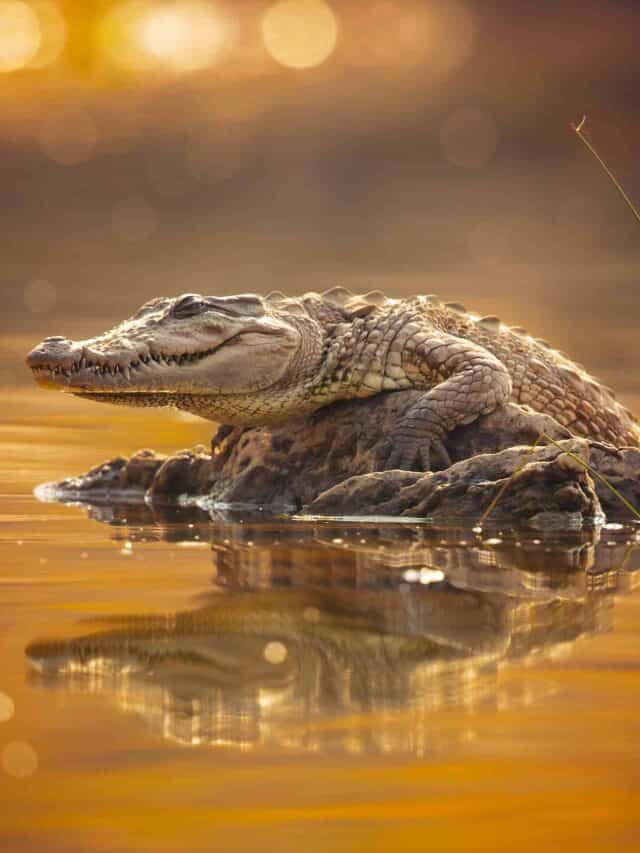Some animals are willing to be ridden. Years and years of breeding and training have made this animal tolerate having a human on their back. But there are other animals that are never going to be happy about having a human straddle them. Now, we all know that crocodiles are one of them but the man in this clip didn’t seem to understand this. And what happened next is both shocking and predictable!
Watch the Heart-Stopping Video Below
How Big Do Crocodiles Get?

The largest, living reptile documented by science, the saltwater crocodile ambushes its prey before drowning it or swallowing it whole.
©Pius Rino Pungkiawan/Shutterstock.com
Saltwater crocodiles are the largest living reptiles on earth – growing to lengths of over 20 feet and weights of over 2,200 pounds! Other species can reach over 17 feet and weigh 2,000 pounds. These massive reptiles begin life around seven inches long – growing fast and eating larger prey as they grow. Baby crocs eat invertebrates and tiny fish before graduating to larger prey. Big crocodiles like the saltwater and Nile species dine on animals as large as buffalo and wild boar. With the most acidic stomachs of any vertebrate – crocodiles can digest almost anything including horns and hooves. Like their avian cousins – crocodiles swallow stones to assist in crushing boney prey – making every animal alive a potential meal.
Crocodile Riding Is Not a Thing!
Let’s be clear. Crocodiles are not trained or domesticated animals. Animals such as dogs, cats, cattle, and some horses have been bred for thousands of years to behave in the way that humans want. Crocodiles have not done this. Whilst some crocs may appear to tolerate humans near them, that does not mean that you can rely on them to behave in a certain way. They are unpredictable and what we see here is a perfect example of that.
It appears that this man has become complacent and thinks that he knows how these crocodiles will react. The fact that he has climbed into their enclosure and is walking confidently around with only a stick to defend himself illustrates this.

Crocodiles can turn and attack with lightning speed.
©Audrey Snider-Bell/Shutterstock.com
He then straddles the reptile, sits on its back, and even slaps the croc on the side of the neck! This is an extraordinary risk to take with a deadly animal.
He is so intent on talking to the gathered crowd that he fails to spot a second croc moving toward him. Perhaps this second croc has interpreted his actions as a threat to their fellow croc? Perhaps it is just curious? Either way, the man swings his stick at it and gets a warning snap in return. This is enough to make him leap off the first croc and stand within striking distance. This is his big mistake.
Crocodile Jaws and Speed
With lightning speed, the croc twists its head and takes a big bite of his thigh. He manages to retreat to the other end of the enclosure and is clearly in pain. However, he is very lucky that the croc does not follow him.

Crocodiles live in warm, temperate, tropical climates.
©Milan Zygmunt/Shutterstock.com
Crocodiles evolved more than 100 million years ago and have changed very little since then. They live in warm, temperate tropical climates and are apex predators. It is not easy to quantify exactly how many crocodile attacks on humans take place each year because many are unrecorded. However, between 1971 and 2004 there were 62 in northern Australia. Bearing in mind that crocs are fast, have a strong biting force, and have sharp teeth, is it really wise to behave like this around them?
Is It Normal Behavior for a Tame Crocodile to Turn on its Trainer?
As we’ve already pointed out, crocodiles are wild animals–not domesticated–and cannot be trusted to behave a certain way, even if they’ve received some training. Crocodiles have a limited capacity to be trained to associate specific objects or cues with a reward like food. This training doesn’t change their innate tendency to behave on instinct.
There will always be safety concerns for professional crocodile handlers, and they must always act with caution. While target training can produce some positive results, crocodiles can’t be domesticated–they cannot be tamed in the strictest sense of the word. They can turn at any point and revert back to wild reactions. Obviously, the handler in this video felt comfortable–too comfortable–but in a moment he was harmed.
The photo featured at the top of this post is © nattanan726/Shutterstock.com
Thank you for reading! Have some feedback for us? Contact the AZ Animals editorial team.






